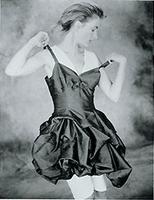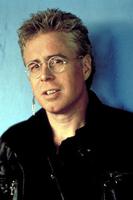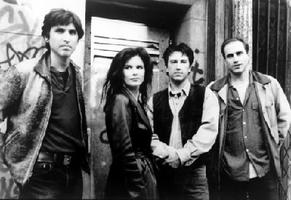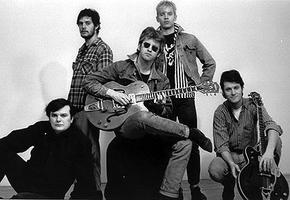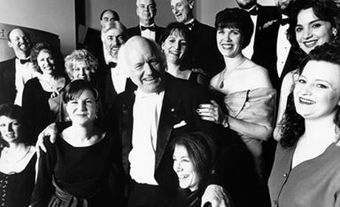Popular Music
In 1996, 3 of the top recording artists in pop, rock and country music were women. More significantly, Céline DION, Alanis MORISSETTE and Shania TWAIN were Canadian women. Not only were they stars in their own country, but individually they had sold millions of records and garnered industry awards and popular recognition internationally. Their achievements, while unique, became symbolic victories for which the Canadian music industry had been striving in the 25 controversial years since the introduction of legislation to create minimum levels of Canadian content in media and stimulate the development of domestically produced popular music.
However, while Dion, Morissette and Twain represented the kind of global success by which the Canadian media chronically have measured its self-esteem, the mid-1990s also marked a time when many other performing and recording acts enjoyed unprecedented popularity in their own country without necessarily having the same impact outside its borders. Still more acts established themselves regionally through independently produced and marketed records that helped to change the shape of popular recording practices while reinforcing regional cultural differences and a national musical identity.
These 3 tiers of development confirmed the existence of a domestic star system and the arrival of a self-sustaining enterprise that appeared at last to have transcended decades of growing pains in the aftermath of the arrival first of rock and roll and, in 1971, of CanCon (Canadian content regulations).
Beginnings
Canadians had been making significant contributions to the development of recorded popular music since the mid-1870s. Thomas Alva Edison, son of a Canadian expatriate, used a piece of tin foil wrapped over a steel drum to play back the words "Mary had a little lamb" in 1877, while Alexander Graham BELL, inventor of the telephone, funded research (by his cousin Chichester Bell) that led to the development of the wax cylinder playing graphophone (1880) and established the American Graphophone Company (1887). Edison representatives recorded Lord DUFFERIN, governor general, at Rideau Hall in May of 1878 on a tin foil machine. That recording is lost. A recording of Lord STANLEY was made in September 1888, and though the original is now lost too, the recording survived through a copy made in 1935.
Émile Berliner, German immigrant and student of electricity and acoustics, designed a mouthpiece transmitter for the telephone in Washington in 1877 that anticipated the basic concept for the microphone. In 1887 he patented the gramophone and in 1893 set up the United States Gramophone Company, which became the Berliner Gramophone Co of Philadelphia in 1896. In 1898, with his brother Joseph, he founded Deutsche Grammophon in Hanover. In 1900, Émile and his son Herbert established a branch of the Berliner Gramophone Co in Montrél to manufacture and distribute their gramophone discs and those of Victor Records throughout Canada.
In 1900, the Berliners purchased the rights to the "His Master's Voice" logo, later the universally recognized "Nipper" trademark of RCA Records, and set up the Compo Company in Lachine, Qué, the first independent pressing plant in Canada. Herbert Berliner also initiated the first system for distributing records independently, and in 1925 introduced the first electronically recorded discs in Canada. The same year Compo issued the first electronically recorded "live" recording, a church service.
As far back as 24 December 1901, Canadian Reginald FESSENDEN transmitted a radio signal from Brant Rock, Mass, to ships at sea. His broadcast of Handel's Largo heralded the beginning of AM radio. Fessenden's other inventions include the wireless telephone, radio compass, the tracer bullet and in 1919 a precursor of the first television. Operating out of Montrél, inventor Guglielmo Marconi laid claim to establishing the first radio station, XWA, in 1919 (or the second, since KDKA in Pittsburgh has made a similar claim).
The Rock Era
Canada's First Pop Superstar
The first Canadian pop superstar was Ottawa's Paul ANKA, who penned the golden perennial "Diana," a song inspired by a crush on his babysitter that was written in 1957 when he was still 16 years old. Without the conventional good looks of a teen idol, he instead had versatility and the ability to write and produce his own songs, talents that saw him compose the pop standard "My Way" in 1968 and the enduring theme music for TV's The Tonight Show.
By the late 1950s, nearly every town in Canada could boast its own Elvis Presley hopeful: Dickie Damron of Bentley, Alta; Gary Cooper of Portage La Prairie, Man; Red Shea of Prince Albert, Sask; Cliff and Jerry of Minto, NB; The Versatiles of Kinnard, BC; Al Oster of the Yukon Territory; The Ducats of Port Aux Basques, Nfld; and Les Trois Clefs of Montréal.
The Band
Rock and roll didn't really arrived until an Arkansas rockabilly singer named Ronnie HAWKINS stormed into Toronto with his band The Hawks. From 1958 to the present, Rompin' Ronnie Hawkins not only has recorded prolifically but has been the unofficial dean of the Canadian school of hard rock, turning out one seasoned, brilliant musician after another. Most notable were the artists who made up the early 1960s version of The Hawks, which later was to become one of the most admired and influential rock and roll groups ever, THE BAND.
The essential lineup of The Band was Richard Manuel, Robbie ROBERTSON, Garth Hudson, Rick Danko and the lone American, Levon Helm. In 1966 they left Hawkins to tour with Bob Dylan during his controversial turn from acoustic folk to electric rock, and, under Dylan's wings, The Band discovered their own gift for songwriting. In 1968 and 1969 they released Music From Big Pink and The Band, albums that were remarkable for melding rock, folk, gospel, soul and country roots into a panoramic yet observant and detailed narrative account of North American folklore and character. The Band enjoyed great success and acclaim but were becoming a frayed and tired unit by the time they disbanded in style in 1976 with the concert The Last Waltz, which also formed the pivotal moment in the movie of the same name, one of the best filmed documentaries of rock and roll.
A reunited version of The Band featuring Helm, Hudson and Danko was still active in the 1990s (Manuel died in 1986). After a decade working behind the scenes in film mainly as a composer, Robertson ventured into a solo career that has yielded 4 ambitious albums reflecting his native heritage and roots to American music.
In fact, it often was noted that some of the wisest commentaries on American life came from the songs of Robertson, a Canadian. Yet strong regional ties and a receptiveness to the influence of climate and geography were qualities in Robertson's writing that he shared with Canadian folk singers such as IAN AND SYLVIA, Gordon LIGHTFOOT and Joni MITCHELL.
Canadian Singer-Songwriters of the 1960s
During the 1960s Canadian singer-songwriters such as Ian and Sylvia, Mitchell and Lightfoot were not only among the most acclaimed recording artists to have an impact internationally, but they also led the way for a continuing parade of singer-writers: Bruce COCKBURN, Murray MCLAUCHLAN, Willie P. Bennett and Stan ROGERS, who contributed some of the most identifiable and distinctive Canadian music of the second half of the 20th century.
While Ian Tyson's "Four Strong Winds" has become a global folk anthem and Lightfoot could eloquently switch from simple romantic imagery in "For Lovin' Me" to epic narrative style for "The Canadian Railroad Trilogy" - songs that both, in their way, communicate Canadian experience - it is ironic and telling that both writers were typical of their time in that they had to find success abroad to be appreciated at home.
Lightfoot has continued to live in Canada; however, others fled to the United States, where they felt their music would be appreciated and would have a chance to be recorded and developed properly. These included John Kay of the hard rock band STEPPENWOLF, Zal Yanovsky of the "good-time" rock band the Lovin' Spoonful, Denny Doherty, a folk singer who became a Papa in the enormously successful folk-rock quartet the Mamas And Papas, pop songwriter Andy Kim, poet, novelist, songwriter Leonard COHEN, "blue-eyed soul" singer David CLAYTON-THOMAS and rock and roll maverick Neil YOUNG.
Young and Mitchell have proven to be the most enduring and influential of them all. Both infiltrated the Los Angeles folk and rock scenes in the mid-1960s, the Winnipeg-bred Young first finding fame with the pioneering rock band Buffalo Springfield. He later teamed up with 1960s-70s supergroup Crosby, Stills & Nash before embarking on an erratic but always intriguing solo career. His numerous albums, such as Everybody Knows This Is Nowhere, After The Goldrush, Rust Never Sleeps, Freedom, Harvest Moon and Sleeps With Angels, reveal a wilfully independent and fearless artist. He is at home with gentle folk and country music but also ready to venture into lesser known modern idioms or to create fierce, uncompromising rock and roll. This spirit and the timeliness (or timelessness) of his smartest work have made him a leader among his contemporaries and a hero to a generation of younger songwriters and rock and roll bands.
Joni Mitchell, meanwhile, remained a solo act but also became part of the Crosby, Stills and Nash circle. From the brave confessional writing of her early albums, she ventured into bolder, more poetic long-form songs and different progressive idioms including jazz, becoming a highly stylized and distinctive artist in the process. In the 1990s her highly regarded albums such as Blue and Court and Spark were cited by numerous women artists including Canadians Sarah MCLACHLAN and Alannah MYLES as inspiration for their own work.
Domestic Music Industry
The success and praise Young, Mitchell, Cohen or Lightfoot earned for Canadian music came at the personal expense of having to record, tour or live outside the country. In the 1960s, Canadian recording studios and record companies lagged behind their American or English counterparts, lacking the technology or expertise to keep up or compete. Canada's independent labels usually existed to service small regional markets and were not very profitable to the few national distributors, such as London or Quality, that stocked their records. The major labels of the time (notably RCA, CBS, Warner Brothers, Capital) were foreign-owned and usually not interested in investing in Canadian recording talent.
The music industry also had very few behind-the-scenes talents such as experienced managers or publicists, and, in the pursuit of amassing larger audiences, Canadian media preferred to program proven hits by established English or American acts over Canadians, often presuming their work to be inferior.
This was an attitude that took root and held on into the 1990s but was exposed as early as 1965, when a recording of the song "Shakin' All Over," by Winnipeg group Chad Allen and the Expressions was presented to radio stations under the name The Guess Who? Not knowing the identity of the band, many assumed it to be one of the latest groups in the 1960s British Invasion (of The Beatles, Rolling Stones etc) and played it. "Shakin' All Over" went on to become a worldwide hit, but when the band's identity was revealed it had to struggle to get another one.
Now reconciled to being The GUESS WHO, Chad Allen and the Expressions became the archetype of Canadian rock and roll, touring the country endlessly and notching more than a dozen modest hits for the Quality label before meeting talented Canadian producer Jack Richardson. Signing to his Nimbus 9 production company, The Guess Who had a huge international single in 1968 with "These Eyes," which became the launching pad for a high-rolling career that produced many more hits, including "American Woman,""Share The Land,""Clap For The Wolfman, "and later solo careers by Randy Bachman and Burton CUMMINGS.
Canadian Content Regulations
The evident lack of support for Canadian talent at nearly all levels of the popular music business prompted the Canadian Radio-Television and Telecommunications Commission to adopt regulations requiring AM radio stations to play at least 30% of records that were demonstrably Canadian - the music or lyrics having been written by a Canadian, the artist being Canadian or the record having been produced in Canada. The ruling came into effect in 1971 with the immediate, desired result being an upturn in record production and exposure to more Canadian talent (seeRECORDING INDUSTRY).
Anne MURRAY was the first star of the CRTC era, although her 1970 multimillion-selling single, "Snowbird," already had established her warm, clear vocal style and taste in light pop, country and folk and laid the foundation for a career that has seen her record over 30 albums, garner numerous JUNO and Grammy Awards and become one of pop music's most recognizable and respected singers.
CanCon Successes of the 1970s
With Canadian media hustling to find ways to program as much proven Canadian content as they could, however, Murray (as well as The Guess Who, Gordon Lightfoot and the middle-of-the-road folk/pop of The IRISH ROVERS) not only benefited from the extra airplay but very nearly suffered from overexposure. It was during the 1970s then, that, given an artificial but necessary incentive to grow, popular music would experience an almost unnatural spurt and suffer the greatest growing pains as a consequence.
On a worldwide scale, the decade was a boom time for the music industry, and Canada's industry also experienced a period of unprecedented record sales for homegrown recording acts as a true star system awkwardly began to take shape. Following the tour-record-tour-record-tour dictum of the Guess Who, many new artists emerged, most notably in rock and roll, and had varying degrees of success at home or abroad: The Stampeders, Fludd, Five Man Electrical Band, CHILLIWACK, Crowbar, LIGHTHOUSE, PRISM, APRIL WINE, Trooper and TRIUMPH.
It became apparent, though, that Canada's small population and the continued resistance of radio and other media still created obstacles to the survival of the independents while the enforced investment by the major labels in Canadian talent was no guarantee of better recordings or easy access to the international market.
Significantly, 2 of the most successful acts to arrive in the 1970s, Bachman-Turner Overdrive (BTO) and RUSH, had 2 of the best and most powerful managers, Bruce Allen and Ray Danniels.
Initially, the Vancouver-based Allen used his high-powered tactics to guide Randy Bachman's BTO to become one of the most successful hard rock acts in the worId, ultimately eclipsing the impact of The Guess Who in the short term. By the time BTO began falling apart in the later 1970s, Allen and co-manager Lou Blair had another immensely popular act in LOVERBOY. In the 1980s, Allen would meet his biggest star, Bryan ADAMS, and by the 1990s would also be managing American country star Martina McBride, goldfingered record producers Bob Rock and Bruce Fairbairn, and pop singer Anne Murray.
Although Danniels has managed other acts and also been behind the creation of the independent Anthem Records label, his earliest, greatest and most consistent success has been with Rush, which in turn has proven itself to be a model of artistic growth and integrity during a career that has endured for 25 years. In that time, Rush has traversed heavy metal, progressive-rock, new wave rock, reggae and other idioms on the way to selling more than 20 million albums worldwide, establishing it as one of the world's most reliable concert attractions.
As the 1970s rounded the corner to the 1980s, a Canadian music establishment had begun to take hold that looked after its own corporate concerns but didn't necessarily reflect the musical climate. While it now had the annual JUNO AWARDS, produced by the Canadian Academy of Recording Arts and Science (CARAS) since 1971 and which was ritually telecast by the CBC to acknowledge the accomplishments of those in the musical entertainment business, the industry showed itself to be conservative and resistant to change. Thus, while it was easy to reward the popular appeal of disco diva Patsy Gallant ("From New York to L.A.") or the sentimental balladry of Dan HILL ("Sometimes When We Touch"), the sociological impact of punk or new wave rock in the late 1970s was resisted with fear and distrust. Thus groups as diverse (and often politically outspoken) as Vancouver's DOA and Pointed Sticks or Toronto's Diodes and ROUGH TRADE became the new, revolutionary spirit of pop musical culture.
Francophone Artists
By the 1970s it was also apparent that French Canada not only had developed an industry that was self-sustaining and culturally in tune with its audience but was growing more apart from its English counterpart.
Although in the 1970s and 1980s there were several examples of a French-English crossover by acts such as Gallant, rock and roller Michel PAGLIARO, teen TV celebrity René Simard, MOR instrumentalist André GAGNON, Manitoban Daniel Lavoie, sister folk duo Kate and Anna MCGARRIGLE or progressive folk/jazz group Harmonium, surprisingly few English pop acts ventured into Québec to reciprocate. Meanwhile, English-speaking Québec acts often remained Montréal-based phenomena (despite the residence of the "indie" Aquarius label and its successful hard rock act, April Wine). Most francophone recording artists - the hugely popular BEAU DOMMAGE, Ginette RENO, Offenbach, Robert CHARLEBOIS - enjoyed their Québécois success largely unknown in anglophone Canada.
While the folk tradition in Québec is lasting (seeFOLK MUSIC, FRANCO-CANADIAN), the transition to pop and more contemporary songwriting began in the 1950s with the CHANSONNIERS led by Félix LECLERC, whose plaintive emotional style blended pithy statements of Québécois sentiment with pointed reflections of cultural and political alienation. When the Québec recording industry created its equivalent of the Junos, it paid homage to Leclerc by calling it the Félix Awards.
Artists who followed his example were Raymond LÉVESQUE, Gilles VIGNEAULT (cited as the most influential and dramatic songwriter of the 1960s), Claude LÉVEILLÉE (who enjoyed a resurgence of popularity in the 1990s), Claude Gauthier, Luc PLAMONDON and Jean-Pierre FERLAND (whose Jaune became the first double-length LP to be released by a Canadian). Québec talent responded to the impact of The Beatles and Bob Dylan in the 1960s with their own versions of anglo-American hits, but inevitably Québec developed its own style through the work of such artists as Pierre Lalonde, Donald Lautrec, Michel Louvain, Johnny Farrago, Renée CLAUDE and René and Nathalie Simard.
Singers such as Ginette Reno and Michel Pagliaro and especially the "enfant terrible" Robert Charlebois took Québécois pop to higher levels of record sales, of rock and roll credibility or of artistic and intellectual merit. Their success helped the industry not only to find its feet but (as was not the case with the English side of the business) to feel secure in the strength and uniqueness of its culture. They soon were joined by a wave of artists covering the range of folk, pop, rock, blues, jazz and disco/dance music, from Richard Seguin to Villes Emard Blues Band to Boule Noire.
If the 1980s saw the development of a global awareness (symbolized in popular music terms by the coining of the term WORLD MUSIC to describe the rhythms mostly of Third World countries, and by the 1985 marathon concert fundraiser for famine-ravaged Ethiopia, Live Aid), it also witnessed the fragmentation of popular music into myriad forms and approaches.
Recording Artists of the 1980s-90s
These trends and concerns were reflected by Canada's pop music as well. Likewise, there was a whole new cycle of artists (and increasingly more of them as the industry came of age) to lead the way or benefit from these developments. Still, the most successful among them are Bryan Adams and producer-writer David FOSTER.
The Vancouver-based Adams first achieved million-selling international record sales with songwriting partner Jim Vallance through such hits as "Cuts Like A Knife,""Heaven" and "Summer Of '69." In the 1990s, a collaboration with writer/producer Robert "Mutt" Lange netted ever bigger hits: "(Everything I Do) I Do It For You,""Please Forgive Me" and "Have You Ever Really Loved A Woman."
Foster, originally from Victoria, made his name in Los Angeles as a session musician but also was the leader of 1970s studio band Skylark and writer of Skylark's evergreen hit, "Wildflower." As a producer, writer and arranger he won Juno and Grammy awards for his work with Chicago, Barbra Streisand, Whitney Houston and others. In 1995 he collaborated with Adams, Vallance and another writer, Paul Hyde (of the then popular Payolas), on the song "Tears Are Not Enough." This was their contribution to African famine relief and, as recorded by Northern Lights, it was a massive group effort that brought together the cream of Canadian talent, including Anne Murray, Gordon Lightfoot, Ronnie Hawkins, Neil Young, Burton Cummings, members of Rush, Loverboy and many others, raising almost $3 million. At Live Aid, "Tears Are Not Enough" was sung by Bryan Adams.
As the 1980s rolled on, the new artists kept on coming: The Payolas, Headpins, Skinny Puppy, Doug And The Slugs, Barney BENTALL and Colin JAMES from the west coast; k.d. LANG, Northern Pikes, and The Pursuit Of Happiness from the Prairies; Red Rider, Jane SIBERRY, Kim MITCHELL, Honeymoon Suite, Glass Tiger, Platinum Blonde, The JEFF HEALEY BAND, The NYLONS (and many more) from Ontario; Gino VANNELLI, Luba and Corey HART from Québec; Haywire and Minglewood from the Maritimes.
With them came a stronger industry infrastructure of managers, publicists, studios, a variety of government or corporate funding opportunities (primarily FACTOR, the Fund to Assist Canadian Talent On Record), trade media (such as RPM and The Record), publishers and indie labels (notably the first and biggest CanCon success, Attic, and the first post-punk/new wave alternative label, Nettwerk) that reinforced and capitalized on an awakening pride in Canada's increasingly sophisticated and original music.
Spearheading the acceptance of rapidly changing 1980s technology and multi-media was the MuchMusic music TV channel (and, later, MuchMoreMusic) and its francophone equivalent, MusiquePlus. Initially relying on pop-rock video clips, MuchMusic's arrival in 1985 not only connected regional activities to the rest of the country but united its many diverse artists and, by focusing on new, emerging artists, created many new stars. These include Grapes Of Wrath, 54-40 and Sons Of Freedom on the West Coast and Sloan on the East.
Canadian pop entered the 1990s on a wave of national pride, much stronger than ever before yet also more diverse, divided and facing the challenges presented by the rapidly expanding vocabulary and opening vistas being created by technology. These took the form of copyright ownership in the face of digitized music relays, communication via World Wide Web sites (seeINTERNET) and the ongoing question of whether Canada still required content regulations. The impact of rap, hip-hop, acid jazz, techno and ever-evolving mutations on dance music was felt most in the large urban centres, particularly in Toronto and Vancouver with their rapidly growing population of black and Asian minorities. Still, despite hit records for Bass Is Base, Maestro Fresh Wes and Kish, few artists working in these idioms were able to sustain much domestic success or use it as a springboard internationally as the new millennium approached.
The francophone music industry had been a mirror of Canadian politics in that it remained distinct, yet during this period it yielded one of the country's biggest stars in Céline Dion.
Dion was a child star in Québec and could have remained astonishingly popular there if she had continued to record in French. She signed to Sony Records in Canada at the beginning of the 1990s and scored the first of many English hits, "Where Does My Heart Beat Now," while risking the alienation of her francophone audience (despite also continuing to record in French). By the time of 1996's Falling Into You album, Dion's warm buoyant personality, bravura singing and choice of slick, commercial romantic ballads and danceable pop had sold millions of albums and earned her Juno, Grammy and Oscar awards. She subsequently married her manager, Pierre Angelli, became a mother and signed a lucrative contract to perform nightly for a year at Caesar's Palace in Las Vegas. At the end of her Las Vegas engagement, she released a new album, Taking Chances, and resumed touring.
The 1990s also marked the coming of age of the Maritimes music industry. As in Québec, it had developed in isolation, its biggest star of the previous 30 years being Springhill, NS, native Anne Murray. Its towering influence was folk songwriter Stan Rogers.
A star system was now in place with its own hierarchy of artists and with a definite legacy with which to cite, the Canadian pop music industry celebrated 25 years of its Juno Awards (and, incidentally, CanCon law) in 1996 with a 4-CD box set, a TV documentary and a book. All were called Oh What A Feeling, the title being a nod to the early 1970s hit record by Hamilton's fiercely Canadian band, Crowbar. The CD box sold the equivalent of a million copies in weeks, qualifying it for a Diamond Award and allowing the industry to pat itself on the back and take stock.
Pop at the Turn of the Century
By the turn of the century, there were hundreds of recording acts of all kinds criss-crossing the country, signed to feisty and street savvy indie labels, licensing their indie compact discs to different countries around the world, promoting themselves via the Internet and building an audience. This was the indie circuit that had begun transforming the careers of Feist, Broken Social Scene, Arcade Fire and The New Pornographers.
As the third millenium began, these performers had begun to force a changing appraisal of exported Canadian music on the international stage while at the same time the impact of Dion and Shania Twain served to enhance the commercial viability of other CanCon acts.
It was the domestic popularity of the Tragically Hip, Blue Rodeo, Jann Arden or the Barenaked Ladies that suggested Canadian popular music could finally be appreciated for its own character and quality at home. These acts spoke directly to Canadians with passion and also with humour about experiences that touched them and yet had universal resonance. Collectively they had sold millions of records and hundreds of thousands of concert tickets. If popular music is measured by sales of records and seats, these were the bands who had done the most to redefine Canadian pop music on the homefront. They were the pivot points between Dion or Twain and the new acts that in growing numbers were now criss-crossing the country in mosquito-crusted vans loaded with their instruments and brand-new self-released compact discs.
A New Century Brings a New Way of Doing Business
By 2008, if technology wasn't leveling the playing field of the Canadian recording industry it was changing it. The sales of compact discs had fallen yet again, by 7%, and there was talk of the CD's demise. Seeming to support this grim prediction, Sam The Record Man, long a symbol of the health of the recording industry, closed its Yonge Street doors in 2006. In May of 2008, A&B Sound (Western Canada's oasis for record sales with its Seymour Street Vancouver store cited as the cheapest place in North America to buy records) went bankrupt. The major corporations - EMI, Warner's, Sony/CBS, Universal - were downsizing, laying off staff, moving to smaller premises or closing branch offices. In Vancouver, for instance, EMI and Sony/BMG laid off staff with their surviving employees now working from home.
Matthew Good and Bryan Adams were Canadians whose latest albums went straight to number one on the Nielsen Soundscan chart. That would be good news but Good's Hospital Songs debuted with 11 000 sales while Adams' 11 notched 10 000. When it's considered that a year before a Celine Dion album could premiere with 10 times those sales, that is not so good.
Adams, who only years before sold in the millions and was one of America's most popular recording acts, didn't have an American label for his 11. A deal was struck with Starbucks Coffee to distribute the record through its Hear Music operation. This wasn't new. Years before, Alannis Morissette agreed to distribute her latest record, an acoustic re-recording of her Jagged Little Pill, exclusively through Starbucks. Record retailers protested and the record was made available conventionally, but the message was clear that established artists had reached an impasse and were now trying to break through it with alternatives. Bob Dylan, Paul McCartney and Joni Mitchell have also released records through Hear Music.
Radiohead, one of the UK's most popular bands, made its In Rainbows available online with fans or the curious told to pay what they wanted. Although Radiohead has never announced how successful this strategy was, and later made the record available on CD in stores, the band wasn't signed to a label at the time and was exploring its options. If nothing else, the ploy got a lot of publicity and sent another clear message to the recording industry. Following Radiohead's example, American band, Nine Inch Nails, marketed an instrumental record this way.
However, neither Radiohead nor Nine Inch Nails were the first. This honour goes to Canada's Jane Siberry. She long ago reclaimed her music and trusted her fans to pay only what they wanted or could.
Why CD sales are down is the source of much discussion but a lot of it has to do with how technology has filled a void - or created one. A large segment of the public now downloads its music via iTunes, Puretracks or other MP3 servers. It doesn't buy records. Facing that reality, several labels, such as Vancouver's Mint or Winnipeg's G7 Welcoming Committee are making their newest releases available digitally first. As well, many new acts don't consider themselves to be part of any recording industry and are staunchly independent. If they know how to use a computer, most indies can arrange their own tours and sell records on their own webpage, myspace, CD Baby, iTunes etc. They can be heard on a variety of internet radio programs internationally rather than hope for airplay on the local commercial radio station.
Not that the old way of advancing a career has been abandoned completely. Commercial radio play and having CDs in stores are still valuable. For every local TV Heart Attack that claims it's content to be an indie in the face of industry turmoil there is a Crash Parallel. Crash Parallel, a Toronto quartet, signed to Sony/BGM with the result, so far, that its World We Know album has benefited from the clout a major label still wields.
Or there is a Michael Buble. His three Warner Bros. albums have sold in the millions. His crooning style is unlikely to get much radio play - although Buble is now writing hits such as "Home" - but it is effective on TV or on tour, where his charm and performance make their strongest impression. He also commands an older audience that grew up buying records.
Buble's exceptional popularity points out an irony in contemporary Canadian music. He is selling both domestically and internationally at a time when Canadian music is getting praise, though the acts receiving this praise aren't well known to the average Canadian. In the vanguard are Montreal's Arcade Fire, Toronto's Broken Social Scene or Vancouver's New Pornographers with many indie bands in the slipstream. All three make good records that international media love. At home, their cultural impact is minor but the international media don't care about record sales or Canadian Content regulations, they just think Canada is a stream of originality and creativity.
It's a hard won independence. For years the Canadian industry was dominant and dictated the rules and was often derivative. Then, along came other means to expose the music and to develop.
Calgary's Feist knows. Known universally by her last name, the highly original Leslie Feist has spent time in Paris and Toronto developing a style that owes a little to punk, pop and performance art but nothing to the Canadian recording industry. In April of 2008, her new album, The Reminder, won her five awards at the Juno Awards. Feist knows and now Canada does, too.
Early International Pop Stars
Of the Canadian pop celebrities before rock and roll's arrival in the mid-1950s, there are at least a dozen notables: Bea LILLIE, comedienne of the First World War years, who was in the cast recording of Berlin's Watch Your Step and Cheap; songwriter Shelton Brooks, whose credits include "Darktown Strutter's Ball" and Sophie Tucker's "Some Of These Days"; Guy LOMBARDO, bandleader, whose Royal Canadians recorded the celebrated, best-known version of "Auld Lang Syne"; Wilf CARTER, also known as Montana Slim, whose homespun country and western repertoire included the utterly charming "Love Knot In My Lariat"; Maynard FERGUSON, a jazz virtuoso whose fame spread internationally from the beginning of his career in the 1950s; pianist Oscar PETERSON, the most respected and honoured jazz musician Canada has produced; composer, producer, multi-instrumentalist Moe KOFFMAN, who completes a trio of the country's most revered jazz veterans; Hank SNOW, a fixture of Nashville's Grand Ol' Opry and probably the only Canadian country writer to have one of his songs, "I'm Movin' On," also become a rock and roll staple; Giselle MacKenzie, light pop singer and musician still remembered as a regular on the American 1950s television show Your Hit Parade; balladeer Robert GOULET, star of Camelot, heart throb, actor of sorts and briefly a cast member of the Howdy Doody Show; Percy FAITH, a musician at the CANADIAN BROADCASTING CORPORATION who became a composer and conductor for Columbia Records in the 1930s and whose biggest hit was "Theme From A Summer Place" in 1960. Finally there were The Four Lads, a Toronto singing quartet that first made its mark backing Johnny Ray on the 1952 hit "Cry." The vocal format of the Lads' biggest hits such as "Moments To Remember" (1955), "No Not Much" and "Standing On The Corner" overlapped and put the foursome somewhere between a barbershop quartet and a black doo-wop group. They were predecessors of 2 more Canadian acts, The Diamonds and The Crew Cuts.
Early Domestic Pop Stars
Prior to rock and roll, radio and then television provided cultural links connecting the country's distant population centres. Canada's vastness and climate had as much to do with the musical and lyrical tone and language of Canadian music as its regional insularity or isolation, which produced music of distinctly different character in the Maritimes, French-speaking Canada, central Canada, the prairies and West Coast.
Besides MacKenzie, Goulet and Peterson, other celebrities who owe their popularity to Canada's domestic media were Wally Koster, JULIETTE, Tommy AMBROSE, Alan Blythe and Tommy HUNTER. Whereas Lucille Starr's international hit "The French Song" or the Maritimes-produced weekly TV series Don Messer's Jubilee (seeDON MESSER AND THE ISLANDERS) had roots in Canada's diverse culture, most of those stars were facsimiles of American entertainers, creating a template for Canadian acceptance that endured at least into the 1980s.
Similarly, after Elvis Presley's pelvically generated shockwaves of 1954 reached Canada a year later, the first Canadian responses to have any national or international impact were pale copies of black rhythm and blues or doo-wop groups: the already mentioned Four Lads, Crew Cuts and Diamonds.

 Share on Facebook
Share on Facebook Share on X
Share on X Share by Email
Share by Email Share on Google Classroom
Share on Google Classroom
